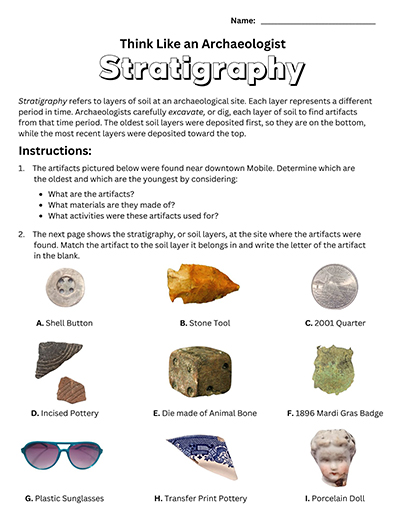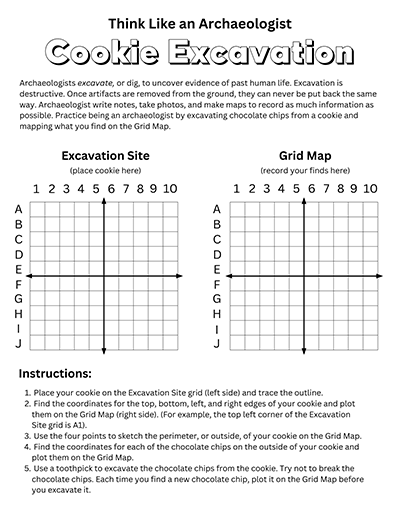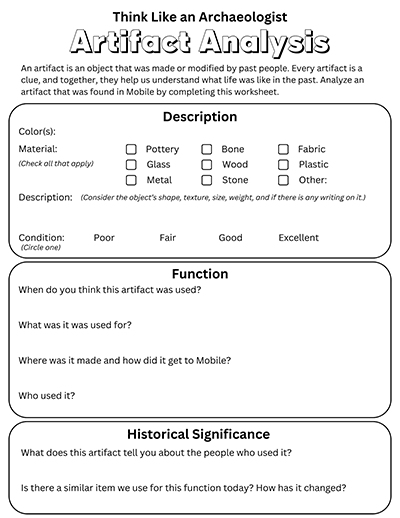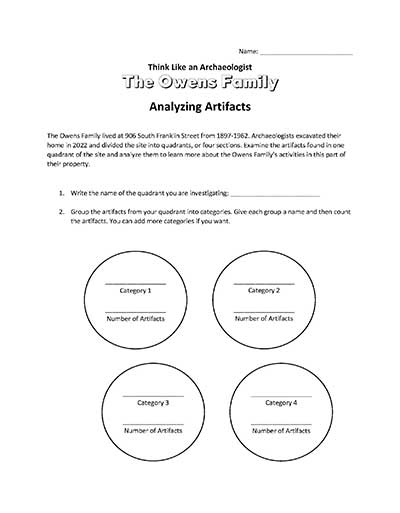Lesson Plans

Archaeology promotes critical thinking, problem-solving, and creativity. It is interdisciplinary, and incorporates science, social studies, math, and the humanities. Our educational series “Think Like an Archaeologist” teaches students the basic principles of archaeology, including excavation and artifact classification and analysis.
Think Like an Archaeologist lessons are aligned with the 2024 Alabama Course of Study Social Studies standards for 1st-8th grades; however, the activities are flexible and can be applied in a variety of courses.
Click on an activity below to download the instructions and worksheet:
Stratigraphy
Learn about stratigraphy, or soil layers, and how it provides a timeline for past activity at a site
7 – Compare and contrast the roles of anthropologists, archaeologists, and paleontologists
8 – Describe Indigenous cultures, governments, and economies in the Southeast prior to European Colonization
1 – Describe major Indigenous societies in North America prior to European contact.
2 – Compare and contrast the reasons for British, French, and Spanish colonization in North America as well as why individuals migrated to the colonies, including mercantilism, religious persecution, poverty, oppression, and new opportunities.
4 – Explain how artifacts and other archaeological findings provide evidence of the nature and movement of prehistoric groups of people.
4b – Describe multiple methods for organizing and labeling periods of time, including differentiating between the BC/AD and BCE/CE notations.
Cookie Excavation
Excavate a chocolate chip cookie and map finds on a grid
10 – Identify cardinal and intermediate directions
10a – Utilize gridlines to find locations on a map
1 – Locate map features, using geographic terminology to describe them.
7 – Compare and contrast the roles of anthropologists, archaeologists, and paleontologists
Artifact Analysis
Study an archaeological artifact from our highlighted finds from the I-10 Mobile River Bridge Archaeology Project
Historic Ceramics
Study historic ceramics, or pottery, from different countries and time periods
8 – Differentiate between the features of a physical map and a political map, and explain how these features contribute to the map’s purpose.
10a – Utilize gridlines to find locations on a map
1 – Locate map features, using geographic terminology to describe them.
7 – Compare and contrast the roles of anthropologists, archaeologists, and paleontologists
The Owens Family
Uncover the history of the Owens Family through primary sources and archaeological artifacts.
7 – Compare and contrast the roles of anthropologists, archaeologists, and paleontologists
16 – Describe how political and social changes of the late 1870s to 1900 affected Black and white Alabamians, including the introduction of Jim Crow laws, sharecropping, voting restrictions, and violence.
1 – Explain how industry and agriculture expanded during the early twentieth century.
3 – Describe Progressive Era social reforms in both the United States and Alabama.
5c – Describe the roles and contributions of Alabamians, including the 167th Infantry Regiment (4th Alabama), to the war effort during World War I.
7a – Explain how the Great Depression impacted Alabamians and the nation, including increased labor tensions.
10 – Describe how Alabamians contributed to the war effort during World War II.
11 – Describe how the United States’ economy grew and American culture changed after World War II.
12b – Trace the chronology of civil rights events in Alabama and across the nation, and summarize how they impacted one another.
Growing Up Down the Bay
Learn about the history of Down the Bay through oral history memories
8 – Describe the features of political and physical maps
11 – Differentiate between primary and secondary sources
12 – Utilize primary sources to examine the significance of individuals, cultures, celebrations, and historical events within the community and state
8 – Differentiate between the features of a physical map and a
political map, and explain how these features contribute to the map’s purpose
10 – Identify cardinal and intermediate directions
15 – Identify and summarize legends, stories, and songs that
contributed to the cultural fabric of the United States
1 – Locate map features, using geographic terminology to describe them








